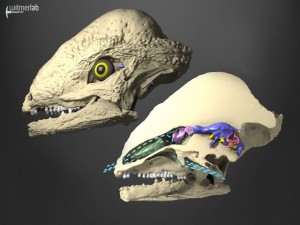A bipedal, German shepherd–sized dinosaur may have had soft tissues in its nasal cavity that cooled the blood flowing to its brain, a new study suggests. The plant-eating Stegoceras validum belongs to a group called pachycephalosaurs (which in Greek means “thick-headed lizards”). CT scans of one particularly well preserved skull revealed delicate scrolls of bones in a chamber at the rear of the creature’s nasal cavity—bones that would have been covered with soft tissue containing smell receptors (purplish pink in reconstruction at lower right), researchers say. A new study modeling fluid dynamics suggested something strange: that air breathed in through Stegoceras’s nasal cavity would have largely bypassed its smell receptors. The mystery was solved after the researchers noticed a small bony ridge in the front part of the creature’s nasal cavity. When the team added soft tissues to that bony ridge—structures called turbinates (in green), similar to those in many modern creatures—they found that inhaled air was diverted back to the olfactory chamber, allowing the dinosaur to better exercise its sense of smell, the researchers reported online this week in The Anatomical Record. The turbinates might have offered other benefits as well. As in today’s ostriches and alligators, hot blood flowing through the soft tissues of Stegoceras’s turbinates would have been cooled before streaming onward to the dinosaur’s brain—possibly helping prevent excess body heat absorbed from a warm environment or generated by vigorous activity from frying the creature’s gray matter.
Ref: Article http://news.sciencemag.org/author/sid-perkins
Key: WFS,Riffin T Sajeev,Russel T Sajeev,World Fossil Society



 December 15th, 2015
December 15th, 2015  Riffin
Riffin 
 Posted in
Posted in  Tags:
Tags: 